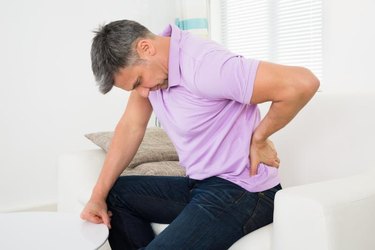
Oh that achin' back! Those lower back muscles seem to complain more than any part of the body. They don't like us sitting at a desk. They don't like us shoveling snow. They don't like us exercising. And they don't even like it when we stay in bed to rest them. Just what is their problem? Could be a few different things, but the treatment is pretty much the same whatever the case.
If the sensation is a generalized discomfort or tenderness in the muscles, the cause is likely Delayed Onset Muscle Syndrome, or DOMS, which is temporary inflammation caused by small tears in the muscle fiber.
Video of the Day
Video of the Day
If the problem is a sharper pain that's triggered by movement, your back muscles may be in spasm. A strained muscle that's in spasm may require more aggressive treatment and take a bit longer to resolve. Unless there's an underlying spinal problem, such as degenerated or bulging lumbar disk, the condition should resolve itself within a few days.
See your health care practitioner if there is severe pain, swelling or numbness, or if it hurts to walk. Otherwise, you can treat the injury at home.
Read More: The Best Exercise for Lower Back Pain
Icing and Heating the Muscles
Heat or cold packs may reduce swelling for lower back injuries, though this has never been proven scientifically to anyone's satisfaction, according to the National Institutes of Health. The conventional wisdom holds that cold is best for fresh injuries and heat preferable for injuries more than a couple of days old. For acute spasms, many chiropractors recommend alternating the two. In this case, first shock the muscle out of spasm by applying ice for 10 minutes or so, then apply heat to sooth it. This cycle can be repeated several times.
No Rest for the Wicked
Unlike other sports injuries, a hurting back does not benefit from being sidelined. According to the NIH, people who forgo bed rest after an episode of low back pain have more flexibility than people who rest in bed for a week. Bed rest can worsen back pain and lead to diminished muscle tone and blood clots in the legs.
Yoga and gentle stretching are recommended for chronic low back pain. Forward bends stretch the hamstring and create space between the vertebrae, relieving pressure on the nerves. Extension exercises such as leg lifting and raising the trunk while lying on your stomach open up the spinal canal and strengthen the muscles that support the spine.
Medication
When choosing an over-the-counter pain medication, you'll probably get more benefit from one of the non-steroidal anti-inflammatory drugs than acetamenophin, which may reduce pain but won't help the inflammation. Taken in sufficient doses, NSAIDS such as ibuprofen, naproxen sodiumand aspirin may actually speed your recovery by reducing inflammation.
If you're in severe enough pain to seek medical help, your doctor may prescribe muscle relaxants for spasms. These, however, should be used with care because they can cause drowsiness while driving and are habit-forming.

Massage and Physical Therapy
Massage has been shown to improve lower back pain and other symptoms across the board. In a trial funded by National Center for Complementary and Integrated Health, 400 people who have low back pain found their symptoms significantly improved after receiving one hour of massage therapy once a week for 10 weeks. Physical therapy and exercises to strengthen core muscle groups in the lower back may also improve posture, promote flexibility and help prevent future injuries.
Preventing DOMS
To avoid lower back pain from DOMS, warm up before your workouts and work your way gradually into high-intensity exercises that involve lifting a lot of weights. DOMS is a reaction to a sudden and large increase in the intensity and repetition of an activity. Easing into a heavier workout over time will reduce your pain and steady your gain.
Read More: 5 Myths About Back Pain Debunked